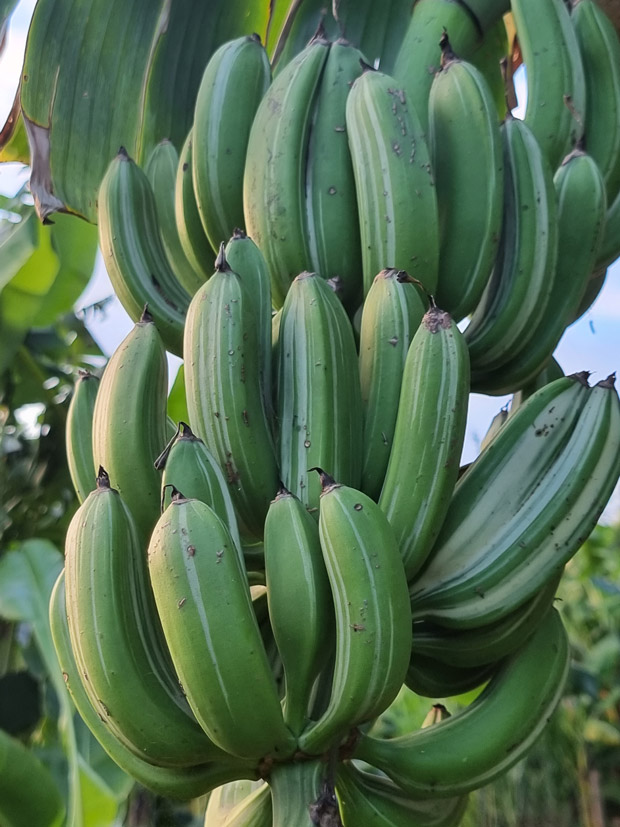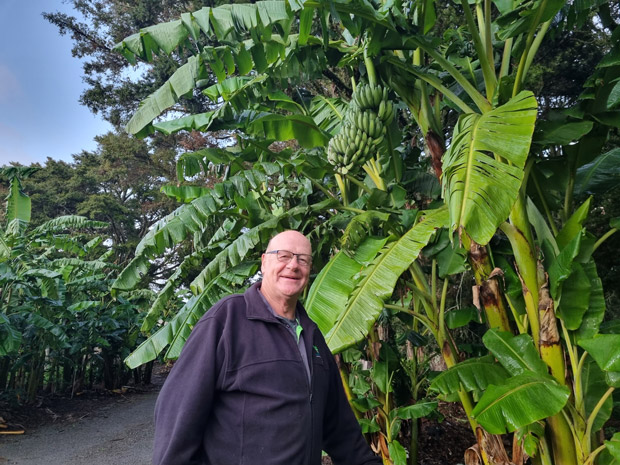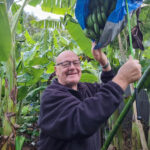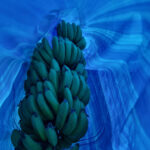5 tips for growing backyard bananas in New Zealand

Banana plants grow widely across New Zealand and even where they can’t bear fruit, they have plenty of other uses.
Words: Michael Andrew Photos: Hugh Rose
Ever wondered why that banana tree in the backyard never produces bananas? Hugh Rose, chair of the Tropical Fruit Growers Association, probably knows. He is an expert in banana growing with 43 varieties thriving on the Northland block he runs with his wife Pauline.
“I’ve been collecting bananas from peoples’ backyards for years. That’s my passion,” he says.

Hugh Rose has 43 banana varieties on his Northland block.
“A lot of banana plants have been in New Zealand for an awfully long time, just quietly growing in grandpa’s back garden. The oldest I’ve got, I can trace back to 1890.”
After years of learning the lore of banana growing, Hugh can identify the kind of banana tree, what to do with it, and why it stubbornly refuses to bear anything remotely edible to humans.
It’s important to identify the variety as many varieties grow in New Zealand. Hugh says the most common edible bananas are lady fingers and misi luki and these are grown as commercial crops throughout Northland.
The other varieties are the Samoan hua moa, or a Cook Island plantain. Hugh says it’s entirely possible to grow cavendish – the common variety found in grocery stores – but these require special attention.
“Cavendish are a special snowflake: they need to be protected from frost and harsh weather. If you use a tunnel house, you’ll get shop-quality dwarf cavendish.”
Being a tropical species, bananas do need plenty of sunlight to flower and fruit. However, that doesn’t mean they’re limited to Northland. Hugh has planted misi luki bananas in the Waikato, where they are now bearing fruit. He shared his top tips to give bananas the best chance to thrive:
1. Treat banana plants like a compost heap
In its natural environment, a banana will flourish with plenty of decaying matter to feed on, such as a fallen tree. A crucial reason why the average backyard banana tree doesn’t look too healthy is because it’s run out of food to eat.
“All it wants to eat is decaying vegetation,” Hugh says. “But once it runs out of its chosen food source, then it becomes weaker and more spindly. Most of the back garden bananas in New Zealand never see blimmin food. That’s one other reason they don’t fruit too well.”
“A banana is one of the few plants that will happily be embedded in a compost heap of little clippings and thrive.”
2. Use the “banana circle”
Hugh’s favourite method of planting bananas is through a permaculture method called a banana circle. It involves digging a shallow pit, one to two metres in diameter and almost a metre deep in the centre.
The dirt should be piled around the outside edge of the hole in a doughnut shape. Fill the pit with compost and organic material; cardboard, paper, leaves and small sticks. Plant the bananas into the doughnut mound of soil surrounding the hole.
“The bananas will happily pop their roots into that pit and turn it very rapidly into much better soil as part of the composting process,” Hugh says. “Give it lots of mulch and lots of feed and you should have fruit.”
3. Beat back the kikuyu
Bananas can do well in parts of New Zealand because there are very few pests and diseases compared to tropical countries. However, kikuyu – a tenacious creeping grass found in coastal and northern New Zealand – can smother banana trees and prevent them from thriving.
Hugh initially sprays the kikuyu then mulches with a thick layer. Once the bananas are big enough to form a canopy, he uses a hoe to whack kikuyu off the plants.
Hugh stresses there is no need to spray the bananas plants.
“Anybody who’s spraying their bananas needs their head examined because we’ve got no pests of significance.”
4. Use banana plants for effluent systems
While bananas may not fruit in colder parts of New Zealand, there are other benefits to a lifestyle block. One is the plant’s reported ability to soak up effluent and leachate from dairy farms, a potential boon for farmers looking to clean up their waterways. The research on this process is still in progress, but Hugh says there are farmers in Northland planting banana trees to improve their effluent systems with great results.
5. Feed it to your stock
Just because the banana plant isn’t fruiting doesn’t mean it isn’t edible – to animals at least. It produces a large amount of forage material that can be used as livestock feed. In fact, that’s how Hugh got into growing bananas in the first place.
“I was beef farming at the time, and growing bananas was an idea to start a retirement fund.
And they supply a steady flow of winter feed for cattle. Every part of the banana plant is edible as far as cows are concerned.”
He says there are plenty of farmers interested in using banana foliage as supplemental feed, which is a fantastic, sustainable alternative to imported palm kernel.
An investigation carried out by AgResearch suggested bananas, which are drought-tolerant, could be hugely beneficial to farms in areas where water shortages are expected to become more severe.



